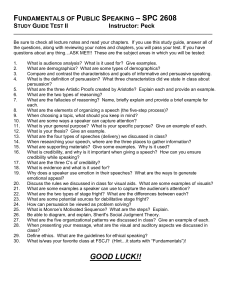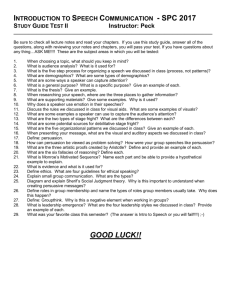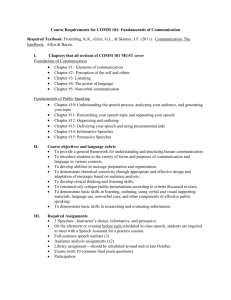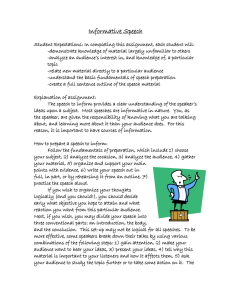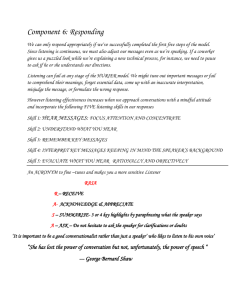Fundamentals of Communication Chapter 1
advertisement
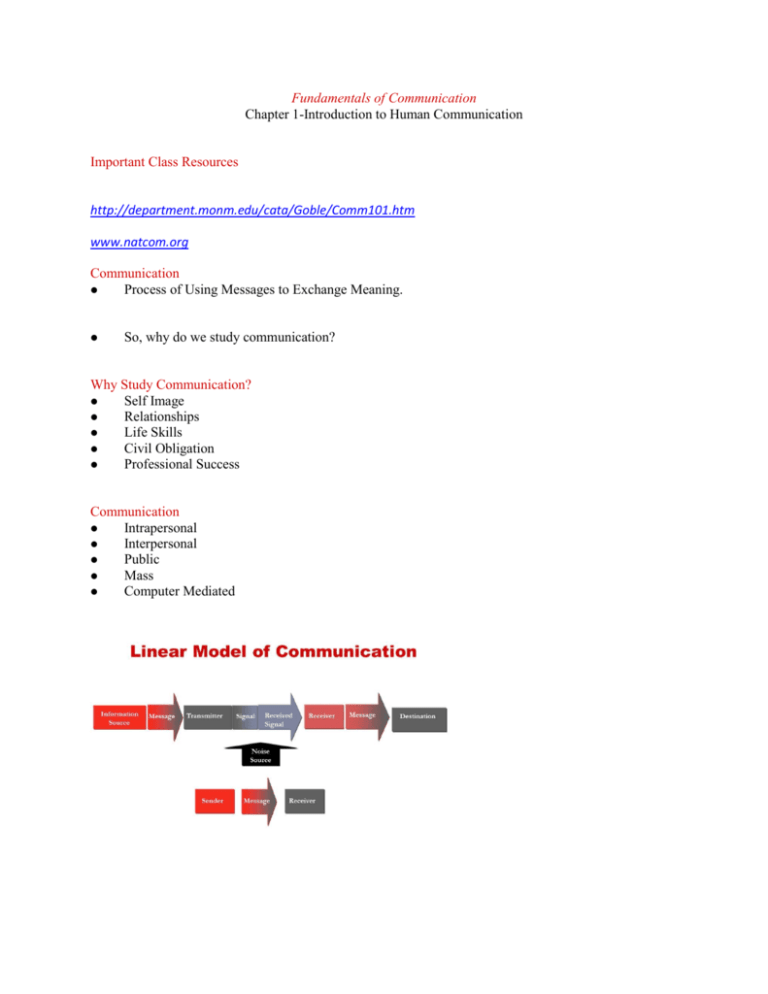
Fundamentals of Communication Chapter 1-Introduction to Human Communication Important Class Resources http://department.monm.edu/cata/Goble/Comm101.htm www.natcom.org Communication Process of Using Messages to Exchange Meaning. So, why do we study communication? Why Study Communication? Self Image Relationships Life Skills Civil Obligation Professional Success Communication Intrapersonal Interpersonal Public Mass Computer Mediated Interactive Communication Model Fundamentals of Communication Chapter 10- Topic Selection and Audience Analysis Choosing a Topic Personal Inventory Brainstorming Narrowing a topic What topics interests you & audience? What topics do you know about & your audience want to know? What topics are you committed to (passion and conviction)? What topics can you find research on? Visual Brainstorming Audience Analysis Voluntary vs. Captive Demographics Interest and Knowledge Attitudes, Values, and Beliefs Methods of Aud. Analysis Observation Inferences Questionnaires Micro targeting Adapting to an Audience Behavior Verbal/Nonverbal Topic Purpose Fundamentals of Communication Chapter 11- Being Credible and Using Evidence Why are you telling us about this topic in this manner? Why = Goal You = Speaker and Knowledge Us = Reason to Listen Topic = Appropriate Manner = Organization & Strategy Credibility Competence Trustworthiness Dynamism Common Ground How do you establish credibility? Research Where would you go if your wanted to find information on a topic that interests you? 4 basic places • Yourself • Library • Internet • Interview and Authority Yourself as Research Source Own experience and knowledge Can enhance credibility Libraries provide rich information on speech topics. Reference Desk. Indexes Databases Internet as Research Source Who’s the author? Reliable source? Is it biased? Complete and accurate info? Intended audience? Up to date info? Good grammar and appropriate language? Web-master identified? Make Research Easier Have a clear purpose Start early Take notes and photo copy Record all possible citation information Evidence Evidence is material used to support claims a speaker makes. • Makes ideas more clear, compelling, and dramatic • Strengthens a speaker’s opinions • Demonstrates ideas • Allows speaker’s to achieve derived credibility Evaluating Sources Clear Verifiable Competent Objective Relevant Seven Types of Supporting Materials Examples Surveys Testimonials Statistics Analogies Explanations Definitions Examples Instances used to make a point, dramatize an idea, or personalize information • Undetailed- quick reference. • Detailed -in-depth descriptions of instances. • Hypothetical -identified clearly- What If • Stories are extended examples in which a great deal of information is woven into a coherent account. Surveys Reliable source Broad sample Who was included? Representative sample Who performed the survey? Why? Statistics Numbers that summarize or demonstrate relationships • Should be limited in a speech • Round off numbers so listeners can understand and retain them Select statistics that are not dated. Example: • ―North Americans make up only 6% of the world’s population, yet they consume 40% to 60% of the planet’s resources. Testimonials Expert with opinions/conclusions of worth Subject expertise Personal experience, Study/research, First hand proof More believable because of this source Analogies Comparison of things Clarification Not proof, but useful as a way to clarify or illustrate. Explanations and Definitions Explanations- Clarify an idea by using the audiences point of view. Definitions- meaning through description, simplification, examples, analysis, comparison, explanation, or illustration. Ethics and Source Credibility True to yourself Ethical goals and purpose Employ ethical means and be honest Obligation to use accurate info Cite the sources Represent the source accurately and fairly. Using Evidence Speech Anxiety Jerry Seinfeld said that public speaking is the most people’s biggest fear, more than death. So most people would rather be in the casket than giving the eulogy. What happens to you when you get nervous? Big Seven Sources of Speech Anxiety Fear of Failure Fear of Disapproval Fear of Unknown Fear of the Spotlight Fear of the Audience Fear of Breaking the Rules Fear of Fear Controlling Speech Anxiety Goal is not to eliminate but to learn to CHANNEL that energy. Nervousness is NATURAL. Nervousness can benefit the speech by adding ENERGY and can ENLIVEN your delivery. Some Coping Strategies Know how you react to stress. Know your strengths and weaknesses. Know speech principles. Know your audience Know your speech Believe in the topic View speech making positively. Project control. Test your message Practice. Learn from Experience Fundamentals of Communication Chapter 4- Language and Meaning Language A collection of symbols, letters or words with arbitrary meanings that are governed by rules and used to communicate. Symbols Arbitrary—they are not intrinsically connected to what they represent Ambiguous—their meanings are not clear cut or fixed Abstract—they are not concrete or tangible Because symbols require interpretation, communication is an ongoing process of creating meanings. Language Use is Rule-Guided Culturally Bound Organizes and Clarifies Reality Sapir-Whorf Hypothesis Language is Arbitrary & Abstract Denotative Meaning Connotative Meaning Language Use (Obstacle or Enhancement) Grammatical Errors Colloquialisms Cliches Euphemisms & Doublespeak Slang Profanity Jargon Regionalism Sexist, Racist, and Heterosexist Language Improving Language Skills Avoid Intentional Confusion (empty language) Use Descriptiveness Be Concrete Differentiate Observations/Inferences Cultural Competence • Each of us has an ethical responsibility to guard against engaging in uncivil speech as well as not tolerating it from others. Fundamentals of Communication Chapter 3 – Listening and Critical Thinking Hearing A physiological activity that occurs when sound waves hit our eardrums Listening Listening Active process Receive and Constructing Meaning Responding to Messages Verbal and Nonverbal 4 types of Listening Active Empathetic Critical Enjoyment Barriers to Listening Noise • Physical • Mental • Factual • Semantic Perception of Others • Status • Stereotypes • Sights and Sounds Yourself • Egocentrism • Defensiveness • Experiential superiority • Personal Bias • Pseudolistening Becoming a Better Listener Listen and think critically Use verbal communication effectively Use nonverbal communication effectively Listening in the Workplace Be self-aware Monitor your nonverbal behaviors Minimize interruptions Ask nonaggressive questions Summarize what the other says to assure you understand Listening in the Classroom Use lecture listening • Find areas of interest • Remain open • Work at listening • Avoid distractions • Listen for and note main ideas Take effective notes • Listen for lecture cues Listening to Media Become a critical consumer of media information Develop information literacy • Recognize when you need information • Know where to find the information you need Check your perceptions of electronic messages Critical Thinking/Listening Analyze situation and message • Communication Context • Speaker’s Argument and Support Material • Speaker’s Observations or Inferences • Speakers Credibility Be an Ethical Listener Recognize the sources of your own conversational style habits Monitor your communication Apply general ethical principles to your responses Adapt to others Fundamentals of Communication Chapter 12- Organizing Your Presentation Overall Organization Strategy Tell us what you are going to tell us Tell us Tell us what you told us Big difference is that a reader can reread. Must make it easy for listener with clear organization. Defining Your Purpose I want my speech to _____________. At the end of my speech, I want listeners to_____________________. To achieve my goal I need to _____________________ ( entertain, narrate, inform, persuade.) Thesis Statement The main idea of the speech • Captures the key message in a short and precise sentence that listeners can remember easily • Is one listeners can grasp at the beginning of your talk and remember after you have finished • Refines what you’ve already done in limiting your topic and defining your purpose The Body is the Substance Supports the central idea or thesis statement. 5-10 minute speeches should have no more that three main points. 11-20 minute speeches can have more points. Questions and answers need more time. Prepare the body of the speech prior to the introduction and conclusion. Organization Strategy A-M-T-O-B-U-L Attention Motivation Thesis Overview Body Underview Last Thought Organization Patterns Time Sequence Cause/Effect Problem/Solution Topical/Sequence Organize the Body- Develop the Key Ideas Four S’s Signpost State Support Summarize (Transition) Designing the Introduction Keys to a Good Conclusion Be Clear Be Memorable Be Brief Summarize the key points Provide closure Summarize Key Points Review the major ideas Listener’s last chance to hear and remember the main points. Repetition reinforces the ideas Helps build to the logical conclusion Provide Closure If summary is the logical end, then closure is the psychological end. DON’T RESORT TO ―In conclusion,‖ Circular conclusion Satisfy questions Call to Action Ways to End Summary Quote Story Personal Feelings Poetic Action Refer to the Beginning Outlines Provide a Clear Concise Profile of the Speech A rough outline provides a basic map of the speech. A formal sentence outline includes all main points, supporting materials, transitions, and bibliographical sources. A key word (speaking) outline includes only key words and is used to trigger the speaker’s memory. Principles of Outlining Each number or letter should represent one idea Consistent numbering system (I.A.1.a.) Must have at least 2 sub-point Complete sentences for each point Parallel grammatical structure. ..\Informative Sample Speech.doc Preparing a Works Cited Section Book • Name of the author or authors • Title • Editor, translator, compiler, if any • Edition, if it is not the first • Place and date of the book’s publication • Name of the book’s publisher • For example: Wood, Julia T. Communication in Our Lives. 4th ed. Belmont, CA: Thompson Wadsworth, 2006 Magazine or Journal • Name of the author or authors • Title or the article • Title of the periodical • Date of the issue • Pages on which the article appear • For example: Prin, Dinah, ―Marriage in the 90’s.‖ New York. 2 June 1990: 40-45 Fundamentals of Communication Chapter 14- Informative Presentations Characteristics of Informative Speeches To impart knowledge To enhance understanding To facilitate the application of information What do you need to know to inform others? Know your goal and intent Know the appropriateness of the topic Know your purpose • What your audience should know or do? • Describe, Distinguish, Compare, Define, State, Show • How will you gauge success? • How does a class do this? Informative Speaking Strategies Create information hunger or a need Relate the information to the audience Use extrinsic motivation and use it early Shaping Informative Content Limit main points Limit # of generalizations Select language aud. Understands Use specifics to illustrate abstract Include appropriate humor but caution Reveal how info meets aud. Needs Avoid info overload Organize for better understanding Informative Presentation Skills Define meanings Describe using specific, concrete language Explain by clarifying and simplifying complex ideas Narrate by using stories to illustrate Demonstrate by showing process and procedure Fundamentals of Communication Chapter 2 – Perception, Self, and Communication Perception Process of becoming aware from senses Active Perception Subjective Perception Perception Physiological factors Past experiences Culture and co-culture Present feelings and circumstances How do we perceive? Selection Organization Interpretation Perception errors Attribution errors • Fundamental attribution error • Self-serving bias Perceptual errors • Stereotyping • First impressions Guidelines for Improving Perception • • • • • • • Recognize that all perceptions are partial and subjective. Avoid mindreading. Check perceptions with others. Distinguish between facts and inferences. Guard against the self-serving bias. Guard against the fundamental attribution error. Monitor labels. Who Are You? What do you know about yourself? • Self-perception • Personal identity Who you are develops through • Intrapersonal communication • Symbolic interactionism • Self-fulfilling prophecy Learning More About Yourself Understand your physical self Understand how others perceive you Understand your communication skills and behaviors What’s Your Future Potential? Self-actualization • The fulfillment of one’s potential How Do You Evaluate Yourself? Self-Appraisal/Self-Concept has two parts • Self-Image • Self-Esteem Self-Image The picture you have of yourself Based on feedback from others • Confirmation • Rejection • Disconfirmation Self-Esteem How you feel about yourself Based on your perceptions of your successes and failures Affects perception and communication Improving Self-Concept Have a goal or objective Make your goal realistic Find information about how to achieve your goal Exercise control and restraint Gain support of friends and family Accept yourself How Do We Present Ourselves? Self-presentation • The way we portray ourselves to others Identity Management • Control (or lack of control) of the communication of information through a performance • High and low self-monitors • Face, facework, politeness Fundamentals of Communication Chapter 5- Non-verbal Communication Which do we believe? When nonverbal and verbal messages are inconsistent, we tend to believe the nonverbal. Non-verbal symbols or codes Bodily movement Facial expression Physical attraction Space Time Touching Vocal cues Clothing and other artifacts Improving Non-verbal Communication Consider all variables Consider all cues Use descriptive feedback Fundamentals of Communication Chapter 13- Delivery and Visual Resources Primary Qualities of Oral Communication It is more informal than written communication. Contractions and sentence fragments are used. Simple sentences are appropriate. Personal stories and pronouns are included. It is more immediate and active that written communication. Repetition is used for retention of ideas. What is Delivery? The communication through voice qualities, bodily actions and language choices Not only shapes speaker image, but also changes, amplifies or undermines the message. Methods of Delivery Impromptu speaking Speaking from memory Speaking from a manuscript Speaking extemporaneously • Practice with notes • Number and check notes order • Determine when look at notes • Slide notes to be less distracting • Devote more time to critical parts Elements of Vocal Delivery Rate and Pause Volume Pitch and Inflection Voice Quality or Timbre Articulation and Pronunciation Rate and Pause Rate • Communicates motive, disposition and involvement • Vary rate to reinforce • 125-190 words per minute average Pause • Reflect on idea • Heighten suspense • Transitions • Intentional (unintentional shows hesitant, unprepared and less credible) Volume, Pitch, Inflection and Voice Quality (Timbre) Volume • 1st step to listening is hearing • Adapt to size of room Pitch • Natural and conversational tone Inflection • Watch monotone or flat tone • Proper inflection gives meaning Timbre • Least flexible part of voice Articulation Most errors are habit, people around you, or illness Four Principle Error Forms • Deletion • Addition • Substitution • Transposition Pronunciation Two vocabularies (Reading and Speaking) Most problems when move from reading to speaking Consult the dictionary Or listen to how other pronounce words Vocal delivery needs to be: Free from errors and mispronounced words Have a pleasant quality Well modulated pitch with energetic inflection Loud enough to hear A rate adapted to the content And pauses used to punctuate ideas and transitions. Elements of Physical Delivery Appearance Posture Facial Expressions Eye Contact Movements Gestures Appearance Don’t underestimate the power of 1st impressions Dress for the Address • Consider occasion • Consider audience • Consider topic • Consider image Posture Comfortable, Confident and Prepared Avoid rigid and sloppy Keep weight balanced Avoid annoying mannerisms Facial Expressions Open mouth and move face for clear articulation Face should register Thoughts and Feelings and Motivate words Concentrate on ideas and how audience reacts to those ideas Eye Contact Show Confidence, Concern, Sincerity, Interest, and Enthusiasm No eye contact shows deceit, disinterest, and insecurity Use to check for audience understanding, interest and involvement. Try to look at every audience member at random Movement Helps relax, energize and loosen up Adds visual variety, helps arouse and retain audience interest Select movement that serves a purpose Lectern is just a barrier, so move out from behind it Gestures Draw picture Indicate size and relations Recreate motion Emphasize key points Point out visuals Trace flow of ideas Coordinate with words Appear natural and spontaneous Large enough for the audience to see Physical Delivery need to be: Free from distracting elements Conversational Forceful As formal and informal as the audience or subject requires Guidelines for Effective Delivery Adapt your appearance to your listeners. Adapt your appearance to the speaking situation. Use gestures to enhance impact. Adopt a confident posture. Use confident, dynamic body movement. Maintain good eye contact with listeners. Use volume that is strong but not overpowering. Use inflection to enhance your message. Use pauses for effect. Do not let accent interfere with clarity. Articulate clearly. Practice Begin practicing your speech several days prior to delivery. Use your key word (speaking) outline when rehearsing. Use all visual aids you plan to use. Practice in front of a mirror, videotape the speech, then when you are comfortable practice in front of friends and family. Practice until you can present your speech extemporaneously but do not memorize it. Importance of Using Visual Resources Gain attention Clarify and reinforce Improve efficiency Types of Visual Resources Objects Models Photographs Drawings Graphs Charts Video Transparencies Multimedia Presentations Speaker Handouts Only use if you can not effectively deliver the information or project it. Distribute after the speech so that they can concentrate on you not the handout Best is used for further study or more information after the speech Selecting the Media Easy to use Audience expectations Availability Adaptability Match Media to the Message Be seen as well as heard- Audience more involved and more responsive Visual Design Principles Preview and highlight Exercise restraint Choose readable font and suitable colors Use appropriate graphics Build sequentially Create an overall look Preparing Visual Resources Do it in advance Keep it simple Make sure its large enough Keep fonts big Limit number of fonts Use color effectively Presenting the visual resources Avoid chalk/white board Display where it can be seen Avoid passing it around Display only when discussed Talk to audience not to visual aid Explain clearly and concisely Practice with them Using PowerPoint Great tool, but misused and overused Only key words not whole speech Use to illustrate points thru visuals Don’t flash it up Read-ability Persuasion Principles of Speech Chapter 15 What is Persuasion? Used in all aspects of life Both verbal and non-verbal communication Nine Principles of Persuasion Persuasion is more likely if goals are limited Adopt Action Discontinuance Deterrence Continuance Nine Principles of Persuasion Persuasion is more permanent if achieved incrementally We can change, but not overnight Small moves always better than asking for large changes Nine Principles of Persuasion Persuasion is more likely is the audience lacks information on the topic Persuasion is related to how important the audience considers the topic Persuasion is more likely if the audience is self motivated in the direction of the message Nine Principles of Persuasion Persuasion is more likely if the speaker’s message is consistent with listeners’ values, beliefs, attitudes, and behavior. Persuasion is more likely is the arguments are paced properly. • Review Toulmin’s model Nine Principles of Persuasion Persuasion is more likely if the source is credible Competence • • • Demo Involvement Relate Experience Cite Research Character Charisma Nine Principles of Persuasion Persuasion is more likely if the speaker establishes common ground with the audience. Basic Questions asked in Persuasive Speech Fact- only work is facts not completely verifiable Value- may be difficult to defend from different opinions Policy- show something should be done • Need • Plan • Solution Prepare and Develop Persuasive Speeches Research Anticipate possible objections Must be able to defend the opposing arguments Provide Evidence that establishes Proof Evidence Tests Consistent known facts Others same conclusions Unbiased sources Qualified source If personal experience how typical is it Stats- reliable, comparable, current, applicable, well interpreted Studies- authoritative, valid, reliable, objective, generalizable Inferences appropriate to data Counterevidence overlooked Presenter credibility Prepare and Develop Persuasive Speeches Organize Should present one side or both? When present strongest argument? What best way to organize? • Monroe’s Motivated Sequence Monroe’s Motivated Sequence Attention Need Satisfaction Visualization Action Prepare and Develop Persuasive Speeches Supporting Material- Classical Appeals Pathos (Emotional) Logos (Logical)• Reasoning- Deductive, Inductive, Causal, Analogy Ethos (Ethical) Mythos (Narrative) Needs (Maslow’s Hierarchy) Prepare and Develop Persuasive Speeches Reasoning Reasoning from Specific Instances (Moving from particular facts to a general conclusion) • Avoid hasty generalization • Wording- qualify your argument • Reinforce- stats and testimony Reasoning from Principle (Moving from general principle to a specific conclusion) • Will audience accept the principle without evidence? • Support general principle you can then support your minor premise and then conclusion. Causal Reasoning • Not always a clear link between cause and effect • Two common errors • False cause- ―Post hoc, ergo propter hoc‖ next event caused by first • Assuming only one cause- oversimplify Analogical Reasoning • Are the two cases being compared essentially alike? Fallacies • Red Herring • Ad Hominem • Either-Or • Bandwagon • Slippery Slope Prepare and Develop Persuasive Speeches Ethics • Accurately cite sources • Respect sources of info • Respect audience • Respect opponent Fundamentals of Communication Mediated Communication and Media Literacy What is Mediated Communication? Mass Communication • Professional communicators use technology to share messages over great distances to influence large audiences Computer-Mediated Communication • CMC • Human-to-human interaction using networked computer environments Why Should You Study Mediated Communication? To become a more critical consumer of the messages sent to you by the media To become a more thoughtful producer of mediated messages Computer-Mediated Communication (CMC) Synchronous communication • Simultaneously sender and receiver Asynchronous communication • Take turns being sender and receiver Types of CMC Electronic mail Bulletin board systems(BBS) Instant messaging (IM) Internet relay chat (IRC) Audio-video conferencing Blogs Virtual worlds CMC and the Communication Process The nature of CMC interactions • Uncertainty reduction in CMC (face to face nervousness) • Impression formation strategies (watch your virtual identity) #1 #2 • Netiquette as a tool for enhancing CMC interactions The role of CMC in community formation • Physical communities form out of geographic pragmatism • Virtual communities form out of psychological similarity Becoming a Literate Consumer of Mediated Communication CMC literacy • • Critically analyze and evaluate CMC Consider the motives and the credentials of all Internet sources What Are the Mass Media? Newspapers Television and radio News magazines The Internet Professional journals What Are the Effects of the Mass Media? Influencing behavior Shaping culture • Gatekeeping • Agenda setting • Creating & perpetuating stereotypes • Cultivating perceptions Becoming a Literate Consumer of Mediated Communication Media literacy • • • Understand how messages are created Recognize the motives behind what the media do Understand that images found in the media contain values and ideologies example
